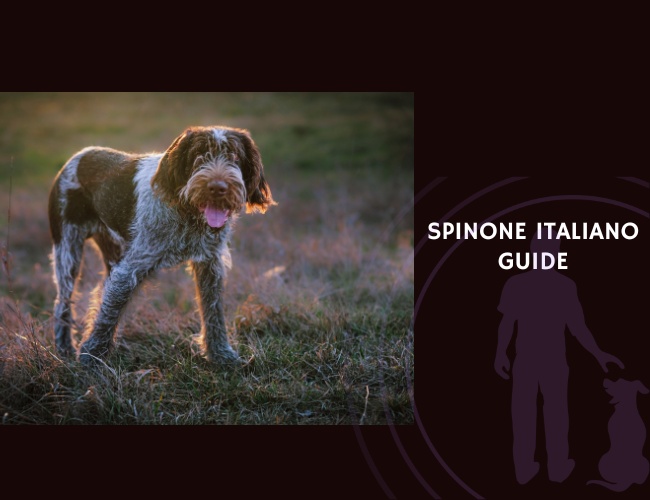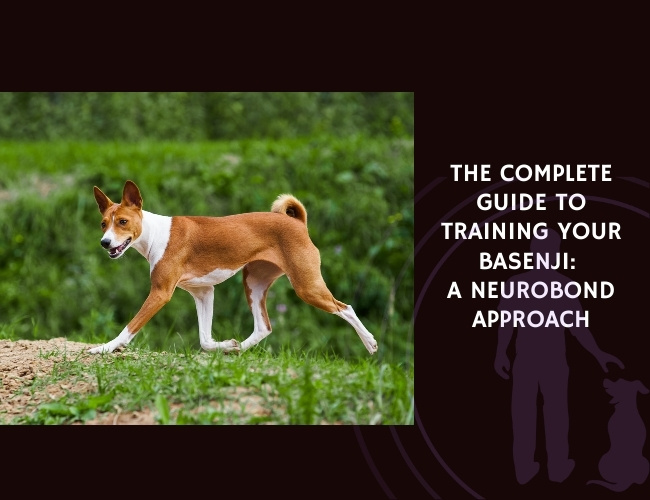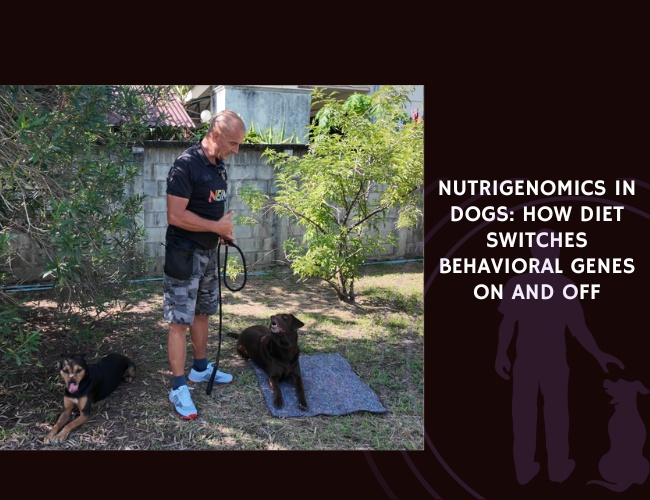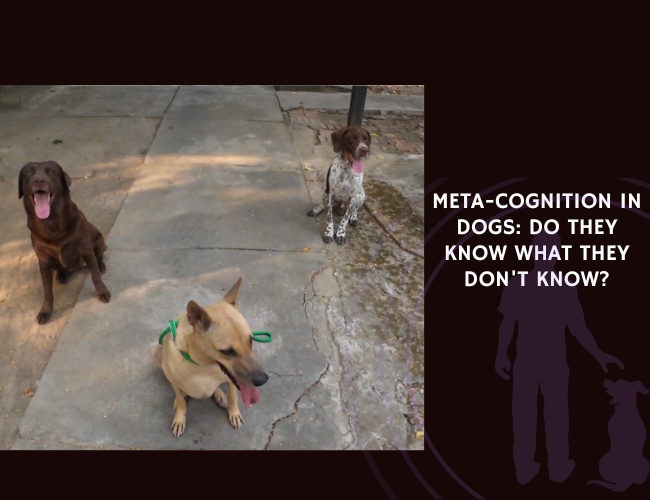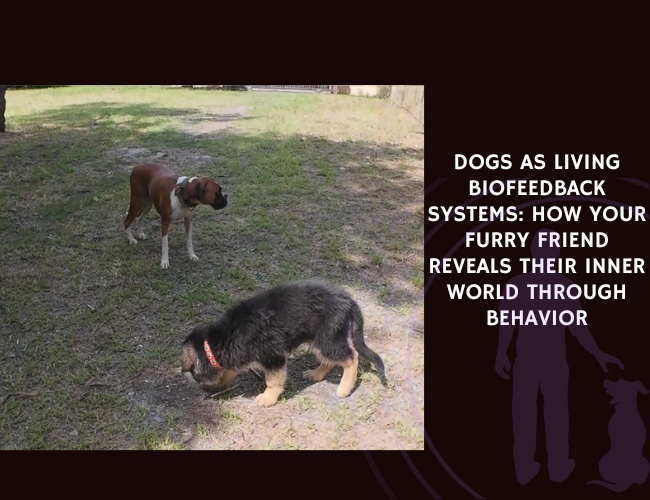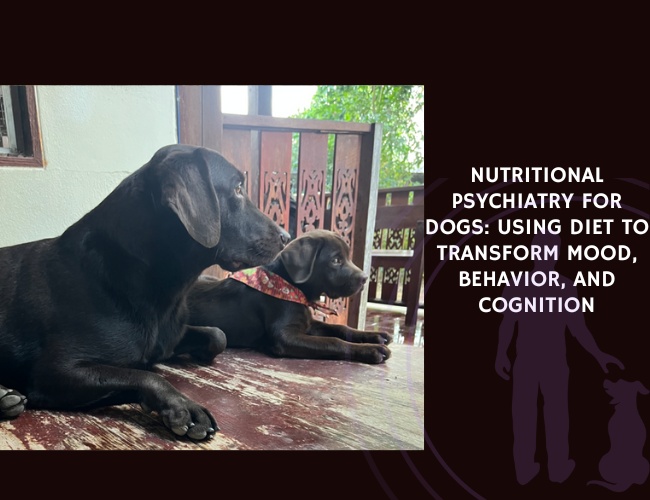Picture a dog with the wisdom of ancient Rome in their soulful eyes, the patience of a saint, and a beard that would make any philosopher jealous. You’ve just imagined the Spinone Italiano—Italy’s treasured hunting companion whose roots stretch back over 2,500 years. This remarkable breed combines the work ethic of a dedicated hunter with the gentle soul of a family guardian, creating a companion unlike any other in the canine world.
From the misty marshlands of Piedmont to modern family homes, the Spinone Italiano has adapted and thrived while maintaining their distinctive character. Whether you’re drawn to their expressive human-like face, their methodical hunting style, or their reputation as one of the most patient breeds with children, understanding the Spinone means appreciating a dog that moves through life with deliberate thoughtfulness and unwavering devotion. Let us guide you through everything you need to know about these remarkable Italian hunters.
Character & Behavior: Understanding Your Spinone’s Ancient Soul
The Heritage That Shapes Today’s Companion
Did you know that your Spinone’s ancestors appear in Italian frescoes dating back to 500 BCE? This isn’t just another hunting breed—it’s a living piece of history. The name “Spinone” comes from “spino,” referring to the thorny undergrowth these brave dogs would navigate without hesitation. Unlike their speedier pointing cousins, Spinoni developed as methodical workers, choosing stamina over sprint, thoroughness over haste.
What makes their working heritage unique: Your Spinone doesn’t just hunt; they partner. Centuries of working alongside Italian hunters in challenging terrain—from dense forests to freezing marshlands—created a breed that reads human intentions with uncanny accuracy. They developed what experts call “cooperative intelligence,” meaning they’re hardwired to work with you, not for you. This translates into a modern companion who watches your face for cues, adjusts their behavior to your mood, and seems to understand your intentions before you’ve fully formed them yourself.
The trotting philosopher: Watch a Spinone move, and you’ll notice something distinctive. They don’t bound or race—they trot with purpose, covering ground efficiently while maintaining energy for the long haul. This measured pace reflects their entire approach to life. Your Spinone thinks before acting, considers before reacting, and chooses their responses with remarkable deliberation. In a world of reactive, high-energy dogs, the Spinone stands apart as the thoughtful friend who always has time to listen 🧡
Temperament: The Gentle Giant’s Emotional Landscape
Your Spinone’s temperament reads like a masterclass in emotional intelligence. These dogs possess a rare combination of sensitivity and stability that makes them exceptional family members. They’re patient enough to endure toddler tea parties, yet alert enough to excel in hunting trials. They’re affectionate without being needy, protective without aggression, and social while maintaining dignified independence.
The patience phenomenon: Spinoni exhibit what behaviorists call “exceptional frustration tolerance.” This means your furry friend can handle delayed gratification, interrupted activities, and changing plans without the anxiety or reactivity seen in many breeds. You might notice this when they’re pointing at a bird—they’ll hold that position with zen-like focus, sometimes for surprisingly long periods. This same patience extends to their interactions with children, making them legendary as family dogs.
Sensitivity and emotional attunement: Here’s something fascinating about Spinone psychology—they’re emotional barometers. Research into canine cognition suggests that Spinoni show heightened awareness of human emotional states, likely developed through centuries of close hunting partnerships. If you’re stressed, your Spinone might quietly lean against your leg. If you’re excited, they’ll match your energy with their distinctive “smile” and gentle tail wag. This isn’t just attachment; it’s genuine emotional reciprocity that creates profound bonds between Spinoni and their families.
Intelligence: The Thoughtful Problem-Solver
Let’s address something important—your Spinone isn’t going to win any speed-learning competitions, and that’s perfectly fine. Their intelligence manifests differently than in breeds bred for rapid command response. Think of them as the careful engineers rather than the quick-fire performers of the dog world.
How Spinoni process information: When faced with a problem, your Spinone engages in what researchers call “sequential processing.” They evaluate the situation, consider options, then choose their response. You’ll see this when they encounter a fence blocking their path—instead of immediately trying to jump or dig, they’ll often walk the perimeter, looking for the optimal solution. This thoughtful approach means training takes patience, but once they learn something, they truly understand it rather than simply performing it.
Scent intelligence: The Spinone’s olfactory capabilities deserve special mention. They can discriminate between incredibly subtle scent variations, building what handlers call “scent pictures”—complex mental maps of an area based entirely on smell. In practical terms, this means your Spinone knows who’s been in your yard, what they were feeling (stress hormones leave scent signatures), and approximately when they were there. It’s like having a furry detective who reads the invisible stories written in scent 🐾
Training & Education: Nurturing Your Spinone’s Potential
Early Socialization: Building Confidence From Day One
The socialization window for your Spinone puppy isn’t just important—it’s absolutely critical for developing their characteristic confidence and sociability. Between 3 and 14 weeks, your puppy’s brain is essentially downloading their understanding of what’s safe and normal in their world.
The gentle approach to brave experiences: Your Spinone puppy needs exposure to diverse experiences, but here’s the key—quality over quantity. Rather than overwhelming them with dozens of quick interactions, focus on positive, calm experiences that build confidence. A five-minute positive interaction with a child who sits quietly and offers treats teaches more than an hour at a chaotic dog park. Remember, Spinoni are sensitive souls who internalize negative experiences more deeply than many breeds.
Creating positive associations: During socialization, you’re not just exposing your puppy to things—you’re teaching them how to feel about those things. Every new person should predict good things (treats, play, gentle petting). Every new surface should offer interesting smells or hidden treats. Every new sound should be followed by praise and rewards. This positive association training capitalizes on your Spinone’s natural tendency to observe and evaluate, helping them conclude that new experiences are opportunities rather than threats.
Field Training: Awakening Ancient Instincts
Even if you never plan to hunt, understanding your Spinone’s field training progression helps you appreciate their natural behaviors and channel them appropriately. These instincts don’t disappear in pet homes—they simply need different outlets.
The pointing instinct emerges: Around 8-12 weeks, you might notice your puppy suddenly freezing when they spot a butterfly or bird. This is the pointing instinct awakening—a behavior so deeply embedded in their DNA that it appears without any training. Encourage this by praising the behavior and using a consistent word like “steady.” Even non-hunting Spinoni benefit from games that utilize this instinct, such as “find it” games with hidden toys.
Developing the soft mouth: Spinoni are naturally “soft-mouthed,” meaning they instinctively carry things gently. You can reinforce this by teaching proper retrieval using progressively delicate items. Start with tennis balls, move to raw eggs (yes, they can learn to carry them without breaking!), and eventually even tissue paper. This isn’t just a party trick—it develops impulse control and reinforces their gentle nature.

Positive Reinforcement: Speaking Your Spinone’s Language
Traditional dominance-based training methods can damage the sensitive Spinone psyche. These dogs respond to disappointment by shutting down rather than trying harder, making harsh corrections counterproductive and potentially harmful to your relationship.
The power of patient persistence: Your Spinone learns best through what trainers call “errorless learning”—setting them up for success rather than correcting failures. If they’re struggling with “sit,” don’t repeat the command louder. Instead, lure them into position with a treat, mark the success with praise, and gradually fade the lure. This approach respects their thoughtful processing style while building confidence.
Motivation matters: Unlike breeds that work for the sheer joy of working, Spinoni need to understand the “why” behind requests. They’re asking themselves, “What’s in this for us?” The answer doesn’t always have to be food—Spinoni often value relationship rewards like gentle praise, chest scratches, or the opportunity to be close to you. Discover what your individual dog values most and use it strategically 😄
Nutritional Recommendations: Fueling Your Italian Athlete
Foundation Nutrition: More Than Just Filling the Bowl
Your Spinone’s nutritional needs reflect both their substantial size (60-85 pounds of muscle and determination) and their moderate to high activity level. But here’s something crucial—Spinoni have what nutritionists call “efficient metabolism,” meaning they often need less food than similarly-sized breeds. Overfeeding is a common mistake that can lead to obesity and exacerbate joint issues.
Calculating your Spinone’s needs: Start with this baseline: an adult Spinone at ideal weight needs approximately 20-25 calories per pound of body weight daily. But that’s just the starting point. A couch-potato Spinone might need only 18 calories per pound, while a working dog could require 30 or more. Watch your dog’s body condition, not just the scale. You should easily feel their ribs with light pressure, see a defined waist from above, and notice an abdominal tuck from the side.
The protein puzzle: Your Spinone needs high-quality protein, but more isn’t always better. Aim for 22-26% protein in dry food for active adults, slightly less (20-24%) for house dogs. The source matters more than the percentage—look for named meats (chicken, lamb, salmon) as the first ingredients, not meat meals or by-products. Their Italian heritage means many Spinoni thrive on fish-based proteins, which also support their coat health.
Joint Support: Protecting Your Spinone’s Framework
With a 12-15% incidence of hip dysplasia in the breed, proactive joint support isn’t optional—it’s essential. This starts with proper nutrition during puppyhood and continues throughout their life.
The growth rate balance: Spinone puppies should grow slowly and steadily, reaching their adult height around 12 months but not filling out completely until 2-3 years. Rapid growth stressed developing joints, increasing dysplasia risk. Choose large-breed puppy formulas with controlled calcium levels (1.2-1.5% dry matter) and avoid supplementing with additional calcium, which can disrupt the delicate calcium-phosphorus balance.
Supplementation strategy: By age 2, even healthy Spinoni benefit from joint supplements. The gold standard combination includes glucosamine (500-1000mg daily), chondroitin (400-800mg), and omega-3 fatty acids from fish oil (approximately 1000mg per 30 pounds of body weight). Green-lipped mussel extract provides a natural source of these compounds plus additional anti-inflammatory benefits. Think of these supplements as insurance for your dog’s mobility in their golden years 🧠
Coat and Skin Health: Nourishing That Distinctive Wire Coat
The Spinone’s harsh, wiry coat with its soft undercoat requires specific nutritional support to maintain its protective qualities and distinctive appearance. Poor nutrition shows quickly in coat quality—it becomes soft, loses its weather resistance, and may develop a greasy feel.
Essential fatty acids are non-negotiable: Your Spinone needs both omega-6 and omega-3 fatty acids in the right ratio (approximately 5:1 to 10:1). Omega-6 fatty acids, found in chicken fat and vegetable oils, maintain skin barrier function. Omega-3s from fish oil reduce inflammation and add coat shine. If your Spinone’s coat feels dry or looks dull, increasing fish oil supplementation often works wonders within 4-6 weeks.
The zinc connection: Spinoni seem particularly sensitive to zinc levels, possibly due to their dense double coat. Zinc deficiency manifests as crusty skin lesions, particularly around the eyes and mouth, dull coat, and slow wound healing. Ensure your food provides at least 120mg of zinc per kilogram of dry matter, and consider supplementation if you notice skin issues.
Steady. Sensitive. Cooperative.
History breathes through them. Spinoni trace back to ancient Rome, bred as deliberate hunters who prized stamina over speed. Their cooperative intelligence makes them natural partners—dogs that read human intention as if it were their own.
Temperament defines their gift. Patient, tolerant, and emotionally attuned, Spinoni embody calm resilience. They wait without frustration, adapt without protest, and mirror the moods of their families with quiet devotion.
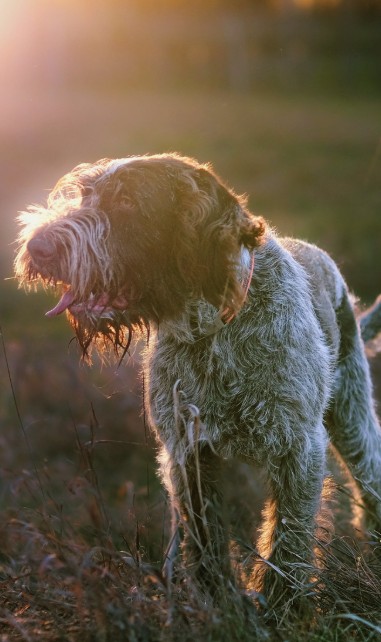
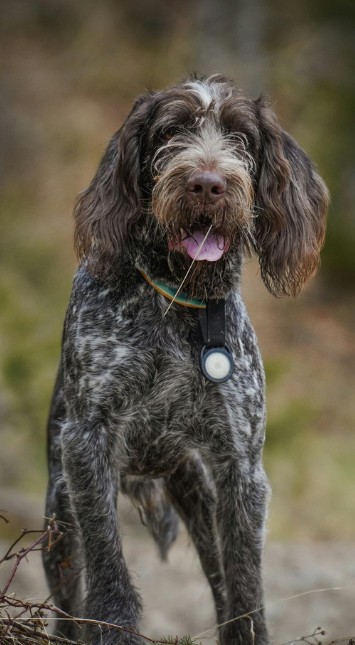
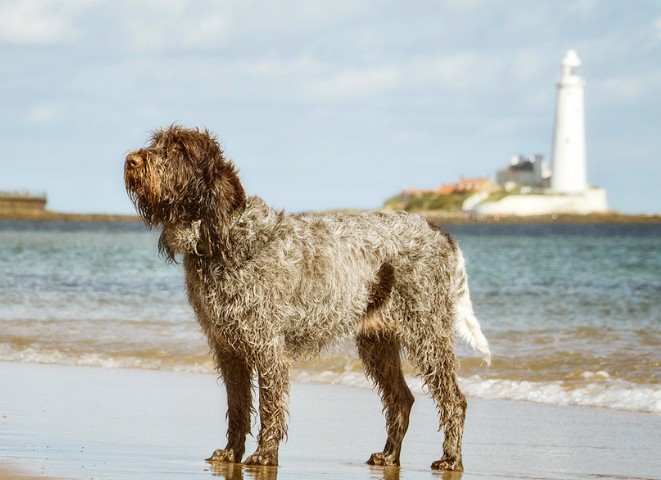
Measured in movement, thoughtful in spirit. From their purposeful trot to their gentle watchfulness, Spinoni move through life like philosophers on four legs—always steady, always connected, always present. 🧡
Health Concerns: Understanding Genetic and Age-Related Challenges
Orthopedic Considerations: Protecting Mobility Through Life
The Spinone’s moderate size and build generally mean fewer orthopedic issues than in giant breeds, but vigilance remains important. Hip dysplasia affects approximately 12-15% of the breed, while elbow dysplasia occurs in 8-10%.
Early detection changes everything: By 6 months, subtle signs might indicate developing joint issues. Watch for bunny-hopping when running, difficulty rising after rest, or reluctance to jump into the car. Early intervention through weight management, appropriate exercise modification, and potentially surgical correction can dramatically improve long-term outcomes. Don’t wait for obvious lameness—Spinoni often hide discomfort until it’s severe.
Exercise intelligence: Young Spinoni need exercise, but the wrong kind can damage developing joints. Follow the “5-minute rule”—five minutes of structured exercise per month of age, twice daily. A 4-month-old puppy needs about 20 minutes of leashed walking twice daily, not hours at the dog park. Save the long hikes and extended retrieval sessions for after their growth plates close around 12-14 months.
The Eyes Have It: Ocular Health in Spinoni
Those soulful Spinone eyes that melt hearts can unfortunately be prone to certain conditions. Entropion (inward-rolling eyelids) affects the breed more commonly than ectropion (outward-rolling), with both conditions having hereditary components.
Recognizing the signs: Early entropion signs include excessive tearing, squinting, or rubbing at the eyes. You might notice your Spinone keeping one eye partially closed or showing sensitivity to bright light. Left untreated, the constant irritation from lashes rubbing the cornea can cause scarring and vision loss. The good news? Surgical correction has excellent success rates when performed by experienced veterinary ophthalmologists.
Preventive care: Daily eye checks become a bonding ritual. Gently wipe away any discharge with a soft, damp cloth, moving from the inner corner outward. Those distinctive Spinone “eyebrows” and facial furnishings can trap debris, so keeping facial hair trimmed around the eyes reduces irritation. During hunting season or after romps through brush, check for seeds or thorns that might have lodged in the eye area 🐾
Living Long and Well: Maximizing Your Spinone’s Years
With an average lifespan of 10-12 years, Spinoni enjoy relatively good longevity for large dogs. However, understanding age-related changes helps you provide optimal care through every life stage.
The cancer conversation: Like many large breeds, cancer accounts for approximately 30% of Spinone deaths, with hemangiosarcoma and lymphoma being most common. While we can’t prevent all cancers, maintaining healthy weight, providing antioxidant-rich nutrition, and avoiding unnecessary chemical exposure may reduce risk. Annual veterinary exams after age 7 should include thorough abdominal palpation and possibly ultrasound screening for early detection.
Thyroid health matters: Hypothyroidism affects 8-10% of adult Spinoni, typically emerging between ages 4-6. The condition sneaks up gradually—your energetic hunting companion becomes a couch potato, their harsh coat turns soft and thin, and they gain weight despite eating the same amount. Annual thyroid screening catches this early, and daily medication restores normal function completely.

Lifestyle & Environment: Creating Your Spinone’s Perfect World
Exercise Intelligence: Meeting Physical and Mental Needs
Your Spinone’s exercise requirements go beyond simple physical activity—they need purposeful engagement that satisfies both body and mind. An hour-long walk through the same neighborhood route might tire their body, but leaves their mind restless and potentially destructive.
The magic formula: Combine physical exercise with mental stimulation for optimal satisfaction. A 45-minute walk becomes infinitely more enriching when you allow sniffing breaks, change routes regularly, and incorporate training exercises. Hide treats along your walking path for impromptu scent work. Practice recalls in safe areas. Let them carry a favorite toy or lightweight backpack with their water and treats. This transforms routine exercise into an adventure that exhausts them mentally and physically.
Swimming—the Spinone secret weapon: Many Spinoni absolutely adore water, and swimming provides perfect exercise for this breed. The buoyancy protects joints while providing resistance training for muscles. Even 15 minutes of swimming equals approximately 45 minutes of walking in terms of energy expenditure. If your Spinone initially seems water-hesitant, try wading in yourself—their desire to be near you often overcomes uncertainty.
Home Environment: From Rural Paradise to City Adaptation
While Spinoni originated as rural hunting dogs, they possess surprising adaptability to various living situations—with appropriate accommodations.
The suburban sweet spot: A house with a securely fenced yard represents ideal Spinone living. They’re not escape artists by nature, but their hunting instincts mean they’ll follow interesting scents if given opportunity. A 5-6 foot fence usually suffices, though some individuals might need reinforcement at the bottom if they discover digging. The yard becomes their kingdom for daily patrols, sunbathing sessions, and important squirrel-watching duties.
Urban living is possible: City-dwelling Spinoni can thrive with committed owners. The key? Daily adventures to parks, regular weekend hiking excursions, and creative enrichment at home. Urban Spinoni often develop stronger bonds with their owners due to increased together-time. However, they may vocalize more in apartments, especially if they hear neighbors through walls. White noise machines and puzzle toys help manage apartment life challenges.
Climate considerations: Your Spinone’s double coat provides excellent insulation, making them comfortable in temperatures from 20°F to 75°F. Below 20°F, limit outdoor time and consider boots to protect paws from salt and ice. Above 85°F, exercise only during cool morning and evening hours. Never shave their coat thinking it will cool them—the coat actually insulates against heat when properly maintained. Provide cooling mats, fans, and plenty of water during summer months 🧡
Family Integration: Your Spinone’s Social World
The Spinone’s gentle nature makes them exceptional family dogs, but understanding their social needs ensures harmonious relationships with all household members.
Children—the Spinone’s special calling: There’s something magical about watching a Spinone with children. They seem to instinctively understand that small humans require extra gentleness. Your Spinone might allow a toddler to use them as a pillow, patiently endure dress-up sessions, and carefully adjust their play style to match a child’s energy. However, always supervise interactions—not because the Spinone might intentionally harm, but because their size could accidentally knock over small children during enthusiastic moments.
Multi-pet households thrive: Spinoni generally welcome other pets as family members. They often bond deeply with other dogs, especially if raised together. Cat relationships depend on early exposure—a Spinone raised with cats typically respects them as family, though strange cats might trigger pointing instincts. Small pets like rabbits or guinea pigs should be introduced carefully, as hunting instincts might emerge despite the Spinone’s gentle nature.
The Daily Rhythm: A Day in Your Spinone’s Life
Understanding your Spinone’s ideal daily rhythm helps create routines that satisfy their needs while fitting your lifestyle.
Morning rituals: Spinoni typically wake slowly, stretching luxuriously before greeting the day. They appreciate a morning routine—bathroom break, breakfast, then a 30-45 minute walk while temperatures are cool. This isn’t a breed that demands 5 AM runs; they’re happy to adjust to your schedule as long as consistency exists.
Midday management: Adult Spinoni can handle 4-6 hours alone without distress, though they prefer company. If you work full-time, consider a midday dog walker or doggy daycare twice weekly. Leave puzzle toys and frozen Kong treats to occupy solo time. Many Spinoni enjoy watching “dog TV”—windows overlooking bird feeders or busy streets provide entertainment.
Evening engagement: This is prime Spinone time. After dinner, they’re ready for their main exercise session—whether that’s a long walk, swimming session, or training class. They particularly enjoy activities that involve the whole family. Post-exercise, they transform into velcro dogs, wanting nothing more than to be near their people, perhaps draped across your feet while you watch TV.
Senior Care: Honoring Your Aging Spinone
Recognizing the Golden Years
Spinoni typically enter their senior phase around age 7-8, though many don’t show obvious aging signs until 9-10. The transition is often subtle—a slight stiffness after rest, choosing the couch over the floor, or taking an extra moment to respond to commands.
Adapting exercise for aging joints: Your senior Spinone still needs daily exercise, but duration and intensity require adjustment. Replace one long walk with two or three shorter outings. Swimming becomes even more valuable, providing exercise without joint impact. On bad arthritis days, mental stimulation through scent games can substitute for physical exercise. Remember, maintaining muscle mass through appropriate exercise actually supports arthritic joints better than complete rest.
Nutritional adjustments: Senior Spinoni often need 10-20% fewer calories to maintain healthy weight, as metabolism slows and activity decreases. However, protein needs might actually increase to maintain muscle mass—aim for 25% high-quality protein unless kidney issues exist. Add supplements like SAM-e for liver support, antioxidants for cognitive function, and increase omega-3s for anti-inflammatory benefits.
Cognitive considerations: Some Spinoni develop canine cognitive dysfunction (doggy dementia) in their final years. Early signs include disorientation, changed sleep patterns, or forgetting house training. Mental stimulation through training, puzzle toys, and new experiences can slow cognitive decline. Medications and supplements exist to support brain function—discuss options with your veterinarian if you notice changes.
Quality of Life: Making Every Day Count
The Spinone’s stoic nature means they often hide discomfort until it’s severe. Regular quality-of-life assessments help ensure their golden years remain truly golden.
The happiness checklist: Can your Spinone still enjoy their favorite activities, even if modified? Do they show interest in family activities? Are they eating with enthusiasm? Can they rest comfortably? If you’re answering “no” to multiple questions, it’s time for a veterinary consultation about pain management or other interventions.
Creating senior-friendly spaces: Simple modifications make life easier for aging Spinoni. Raised food bowls reduce neck strain. Orthopedic beds support arthritic joints. Ramps help them access cars or favorite furniture. Non-slip rugs prevent falls on slippery floors. These small changes can dramatically improve comfort and maintain independence longer.
Conclusion: Is the Spinone Italiano Right for You?
After exploring the depths of the Spinone Italiano’s character, needs, and care requirements, you might be wondering if this remarkable breed fits your lifestyle. Let’s be honest—the Spinone isn’t for everyone, and that’s perfectly okay. They require patience, dedication, and an appreciation for a dog that moves through life at their own thoughtful pace.
You might be perfect for a Spinone if you:
- Value companionship over performance
- Enjoy outdoor activities but don’t need a marathon partner
- Have patience for training a thoughtful, sensitive dog
- Can commit to regular grooming and exercise needs
- Want a family dog with exceptional gentleness
- Appreciate a dog that thinks before acting
- Have space for a large, occasionally muddy, always loving companion
You might want to consider another breed if you:
- Need a dog that learns commands rapidly
- Want a jogging or high-intensity exercise partner
- Prefer minimal grooming requirements
- Have limited time for daily exercise and interaction
- Want a guard dog or protection animal
- Are looking for a highly independent breed
The Spinone Italiano offers something increasingly rare in our fast-paced world—a reminder to slow down, observe carefully, and approach life with patience and deliberation. They teach us that the journey matters more than the destination, that gentleness is a strength, and that the best things in life are worth waiting for.
If you decide to welcome a Spinone into your life, you’re not just getting a dog—you’re gaining a philosopher, a comedian, a patient teacher, and a devoted friend. You’re becoming part of a tradition that stretches back millennia, connecting you to Italian hunters, ancient Romans, and countless families who’ve discovered the unique joy of life with a Spinone.
Your Spinone won’t be the fastest dog at the park, the quickest to learn new tricks, or the most energetic playmate. But they will be the one who waits patiently while you tie your shoes, who checks on every family member before settling for the night, and who looks at you with those ancient, knowing eyes as if to say, “There’s no rush, my friend. We have all the time in the world.”
And in those moments, watching your gentle Italian companion navigate the world with their unique combination of dignity, humor, and boundless affection, you’ll understand why Spinone owners often say they’ll never have another breed. Because once you’ve been loved by a Spinone Italiano, every other dog seems to be missing something essential—that indefinable quality that makes them not just pets, but true partners in the beautiful, messy, wonderful journey of life 🧡

